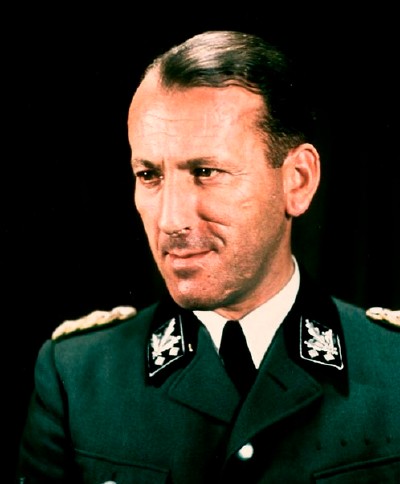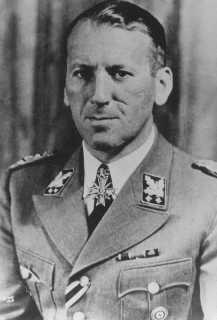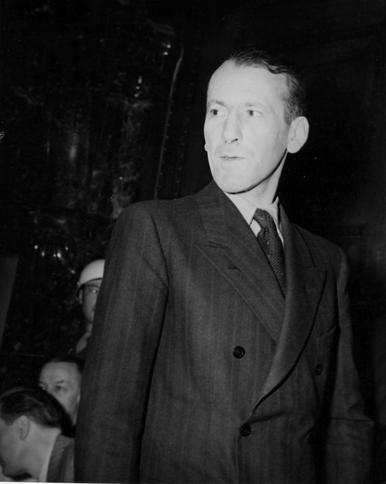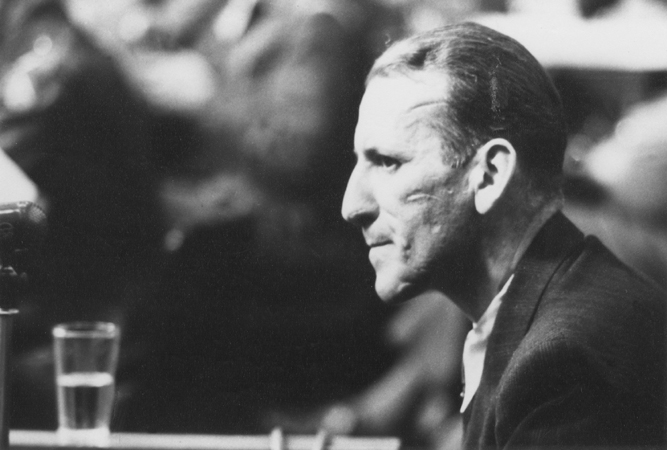<Back to Index>
- Director of the Reich Main Security Office Ernst Kaltenbrunner, 1903
PAGE SPONSOR


Ernst Kaltenbrunner (4 October 1903 - 16 October 1946) was an Austrian born senior official of Nazi Germany during World War II. Between January 1943 and May 1945, he held the offices of Chief of the Reichssicherheitshauptamt (RSHA, Reich Main Security Office), President of Interpol and, as a SS - Obergruppenführer und General der Polizei und Waffen - SS, he was the highest ranking Schutzstaffel (SS) leader to face trial at the first Nuremberg Trials. He was found guilty of war crimes and crimes against humanity and executed.
Born in Ried im Innkreis, Austria, Kaltenbrunner was the son of a lawyer, and was educated at the State Realgymnasium in Linz and at Graz University. He obtained a law degree in 1926, and briefly worked as a lawyer in Linz and Salzburg. He was a very tall man, standing just over 6' 7" (201 cm) tall, and had deep scars on his face from dueling in his student days. However, according to some sources, these "dueling scars" were actually the result of an alcohol related driving accident.
Kaltenbrunner joined the Nazi Party and his NSDAP number was 300,179. In 1932, he joined the SS in Austria. His SS number was 13,039. He was the Gauredner (district speaker) and Rechtsberater (legal consultant) of the SS Division VIII. In January 1934, Kaltenbrunner was briefly jailed by the Engelbert Dollfuss government with other National Socialists at the Kaisersteinbruch concentration camp. In 1934, he was jailed again on suspicion of High Treason in the assassination of Dollfuss. This accusation was dropped, but he was sentenced to six months for conspiracy. In 1934, Kaltenbrunner married Elisabeth Eder (b. 1908) and they had three children. In addition to the children from his marriage, Kaltenbrunner had twins, Ursula and Wolfgang, (b. 1945) with his long time mistress Gisela Gräfin von Westarp (née Wolf). All of his children survived the war.
From mid 1935 Kaltenbrunner was the leader of the
Austrian SS. He assisted in the Anschluss and Hitler promoted him to SS - Brigadeführer
on the day the Anschluss was completed. On 11
September 1938 he was promoted to the rank of SS - Gruppenführer.
He was also a member of the Reichstag from 1938.
In July 1940, he was commissioned as a SS - Untersturmführer in the Waffen - SS Reserve. Later in April 1941, he was promoted to Major General (Generalleutnant) of the Police. On 30 January 1943 Kaltenbrunner was appointed Chief of the RSHA, composed of the SiPo (Sicherheitspolizei: the combined forces of the Gestapo and Kripo) along with the SD (Sicherheitsdienst: Security Service). He replaced Reinhard Heydrich, who was assassinated in June 1942. Kaltenbrunner held this position until the end of the war. He was promoted to SS - Obergruppenführer und General der Polizei on 21 June 1943. He also replaced Heydrich as President of the International Criminal Police Commission (ICPC), the organization today known as Interpol.
Toward the end of the war, Kaltenbrunner's power
increased greatly, especially after the attack on Hitler
of 20 July 1944, upon which he gained direct access to the
Führer. He was also responsible for conducting kangaroo
trials and calling for the execution of all the people who
were accused of plotting against Hitler. It was often said
that even Heinrich Himmler feared him and he managed to be
an intimidating figure with his height, facial scars and
volatile temper. It was rumored that he was responsible
for Adolf Eichmann's failure to attain the rank of SS -
Colonel. Kaltenbrunner was also long time friends with
Otto Skorzeny and recommended him for many secret
missions, allowing Skorzeny to become one of Hitler's
valued agents. Kaltenbrunner was also responsible for
heading Operation Long Jump, the attempt to assassinate
Stalin, Churchill, and Roosevelt. Following Himmler's
appointment as Minister of the Interior in August 1943,
Kaltenbrunner sent him a letter wherein he argued that
Himmler's new powers must be used to reverse the party
cadre organization's annexation.
In December 1944, Kaltenbrunner was granted the rank of General of the Waffen - SS. Other SS General Officers were granted equivalent Waffen - SS ranks in 1944 as well, so that in the event that they were captured by the Allies, they would have status as military officers instead of police officials. For those who had held police rank prior to 1944, the SS General's title could become rather lengthy. Kaltenbrunner was listed on the SS rolls in 1945 as SS - Obergruppenführer und General der Polizei und Waffen - SS. On 9 December 1944 he was awarded the Knights Cross of the War Merit Cross with Swords. In addition he was awarded the Golden NSDAP party badge and the Blutorden.
On 18 April 1945, Himmler named Kaltenbrunner Commander - in - Chief of
those remaining German forces in Southern Europe.
Kaltenbrunner reorganized his intelligence agencies as a
stay - behind underground net. He divided the subcommands
between Otto Skorzeny, head of the sabotage units, and
Wilhelm Waneck, who kept in contact not only with
Kaltenbrunner and other centers in Germany, but also with
stay - behind agents in the southern European capitals.
In late April 1945, Kaltenbrunner fled his headquarters from Berlin to Altaussee, where he had often vacationed and had strong ties. While there, he opposed and thwarted the efforts of local governor August Eigruber to destroy the huge and irreplaceable collection of art stolen by the Nazis from museums and private collections across occupied Europe (more than 6,500 paintings plus statuary) which had been intended for Hitler’s planned Führermuseum in Linz.
These were stored in a nearby extensive complex of salt mines. Eigruber was determined to carry out what he was determined was Hitler's true desire – to prevent the collection from falling into the hands of "Bolsheviks and Jews" by destroying it with explosives set off in the mine. Working with Dr. Emmerin Pöchmüller, the mine overseer, Kaltenbrunner countermanded the order and had the explosives removed. Thus he participated in the salvation of such world treasures as Michelangelo’s Madonna of Bruges stolen from the Church of Our Lady in Bruges, and Jan van Eyck’s Ghent Altarpiece stolen from Saint Bavo Cathedral in Ghent; Vermeer’s The Astronomer and The Art of Painting.
On 12 May 1945 he was captured by a U.S. patrol and
arrested.
At the Nuremberg Trials, Kaltenbrunner was charged with conspiracy to commit crimes against peace, war crimes and crimes against humanity. The most notable witness in this trial was Rudolf Höss, the camp commander of the Auschwitz concentration camp.
Kaltenbrunner's close control over the RSHA meant that direct knowledge of and responsibility for the following crimes were ascribed to him:
- Mass murders of civilians of occupied countries by Einsatzgruppen;
- Screening of prisoner of war camps and executing racial and political undesirables;
- The taking of recaptured prisoners of war to concentration camps, where in some cases they were executed;
- Establishing concentration camps and committing racial and political undesirables to concentration and annihilation camps for slave labor and mass murder;
- Deportation of citizens of occupied countries for forced labor and disciplining of forced labor;
- The execution of captured commandos and paratroopers and protection of civilians who lynched Allied airmen who had been shot down over German occupied territory;
- The taking of civilians of occupied countries to Germany for secret trial and punishment;
- Punishment of citizens of occupied territories under special criminal procedure and by summary methods;
- The execution and confinement of people in concentration camps for crimes allegedly committed by their relatives;
- Seizure and destruction / spoilation of public and private property;
- Murder of prisoners in SiPo and SD prisons;
- Persecution of Jews;
- Persecution of churches and religions;
- Persecution of gypsies.
During the initial stages of the Nuremberg trials,
Kaltenbrunner was absent because of two episodes of
subarachnoid hemorrhage. His lawyer Kurt Kaufmann
requested that Kaltenbrunner be acquitted on grounds of
health complications as he was medically unfit for the
trial. Kaltenbrunner's state of health improved and the
tribunal denied his request for pardon. When Kaltenbrunner
was released from a military hospital he pleaded not
guilty to the charges of the indictment served on his
person. Kaltenbrunner stressed during cross examination
that all decrees and legal documents which bore his
signature were "rubber - stamped" and filed by his
adjutant(s).
Kaltenbrunner was incumbent in his defense that Himmler
was culpable for the atrocities committed during his
tenure as chief of the RSHA. During the trial he stressed
that his position existed only in title and was only
committed to matters of espionage and intelligence. The
IMT (International Military Tribunal) noted that
Kaltenbrunner was a keen functionary in matters involving
the sphere of the RSHA's intelligence network, but the
evidence also showed that Kaltenbrunner was an active
authority and participant in many instances of war crimes
and crimes against humanity. On September 30, 1946 the IMT
found Kaltenbrunner not guilty in matters of conspiracy
for aggression concerning the charge of the indictment.
However, Kaltenbrunner was found guilty of war crimes and
crimes against humanity. On October 1, 1946 the IMT
sentenced Ernst Kaltenbrunner to death by hanging.
Kaltenbrunner was executed by hanging at around 1:40 a.m. on 16 October 1946. Kaltenbrunner's last words were:
In 2001, Ernst Kaltenbrunner's personal Nazi security seal was found in an Alpine lake, 56 years after he threw it away in an effort to hide his identity. The seal was recovered by a Dutch citizen on vacation. The seal has the words "Chef der Sicherheitspolizei und des SD" (Chief of the Security Police and SD) engraved on it. Experts have examined the seal and believe it was discarded in the final days of the war in May 1945. It was one of Kaltenbrunner's last acts as a free man. Kaltenbrunner gave himself up claiming to be a doctor and offering a false name. However, his mistress spotted him, and by chance occurrence, she called out his name and rushed to hug him. This action tipped off the Allied troops, resulting in his capture, trial and execution.I have loved my German people and my fatherland with a warm heart. I have done my duty by the laws of my people and I am sorry this time my people were led by men who were not soldiers and that crimes were committed of which I had no knowledge. Germany, good luck.

